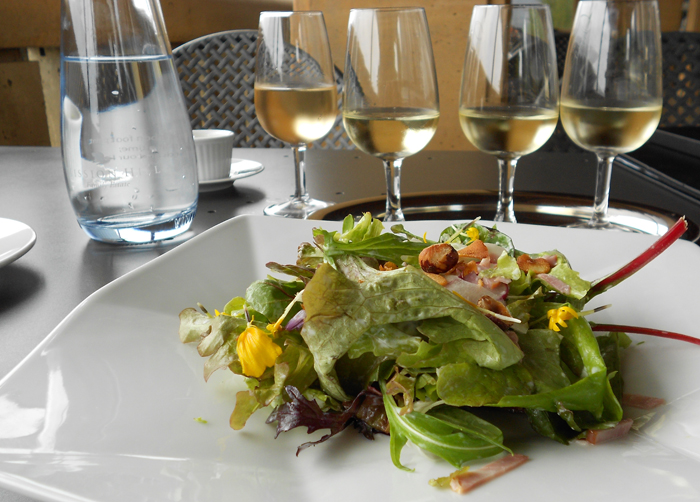Okay folks this is it, a genuine scoop. You heard it here first: It is now safe to go back into chard infested waters!
For most of the ’90s chardonnay was the most popular white wine on the planet. Californian and Australia ruled and consumers couldn’t get enough of the stuff.
The key to the wildly popular wine was a fleshy, orotund set of textures that had absorbed exotic flavours from new American oak; and had the edge ground off its acidity via malolactic fermentation (MLF). By 2000 this combination had become so popular American oak was up by about forty per cent in price and tech millionaires who fancied themselves as winemakers were hoping to sell Starbucks on the health benefits of MLF.
Meanwhile nasty grumps like myself fled into the night, grinding molars, rending garments and crying to the blasted heath. Where is the chardonnay I know and love? Our only company was the court jester, who typically offered up the cold comfort of Bacardi Breezer as alternative.
 I gave up. Literally. For all intents and purposes I drank no chardonnay for over a decade. This was no small sacrifice on my
I gave up. Literally. For all intents and purposes I drank no chardonnay for over a decade. This was no small sacrifice on my
part. To give you perspective, when Sairey and I lived in Bermuda we had the liquor store deliver a case of premier cru Chablis to our door every three or four weeks.
About once a year for the last five years Iíve been dipping my tongue in the barrels, searching like Diogenes for one honest wine, or at least signs of improvement. It has been a long, and rather hard road, but then being a wine critic is nobodyís idea of an easy gig.
Improvement there has been. Winemakers firstly went back to square one, fermenting the wine in stainless steel. This saved money and ensured all the flavours came from the yeast and grape.
I suspect that the unoaked experiment made winemakers enormously more respectful of their yeast strains. Certainly something has changed. Maybe just the pendulum swung and the market now prefers a less crazed version of Chardonnay.
Lately they have started to use more French oak, which these days is hugely expensive. Large American wineries have told me they pay between $1000 and $1100 for a new French barrel landed on the west coast. Partly to save cost, and partly to produce a more elegant palate, the typical recipe these days is a blend of stainless steel fermented and oak fermented wines. This provides that slight whisper of flavour of vanilla and caramel without overpowering the fruit.
Bin 65 makes an interesting example of this history. This wine embarrassed most of Californiaís winemakers in the ë90s, regularly outscoring them by several points while costing anywhere from half to a quarter what Californians were demanding.
You can actually track the rise and fall of Chardonnay in the scores awarded to this wine. Around 1991 it would earn an 87 from the Wine Spectator, but by 2006 it was down to an 81. It has since recovered to 85 but the critics are still feeling shy.
The wine (and all of those listed here) is enormously pale yellow, as opposed to the urine sample look of a few years ago. This is a sign of more gentle oaking. The bouquet is slightly delicate and fruity. The palate sports good acidity without being aggressive – something many drinkers will appreciate, and the finish is mildly astringent.
In short this is an understated, well made, wine that will reward the thoughtful drinker.
Wolf Blass Yellow Label completely lost their way when they were owned by Fosters. Quelle surprise. Itís the palest of these wines, but extraordinarily well balanced with a mineral finish, something you almost never get from Oz wines.
Saireyís fave was another old warhorse, Rosemount Diamond label. Facing a collapsing market, Rosemount has made a number of changes including losing the expensive diamond shaped bottle. It was remarkably similar to Bin 65 in profile, and Iím not sure Iíd be able to pick them apart in a blind test.
Koonunga Hill was a money spinner for Penfoldís for a while. Apparently new management is attempting to restore the honour and the apostrophe to the name. It was the darkest of these wines. The palate and bouquet were even tempered, with flavours of citrus and a lightly acidic palate. It finished with the slightest whisper of mineral. It was my favourite of these wines.
Wyndham Estate Bin 222 was almost as dark a wine with a floral, slightly citrus bouquet and an interesting palate with a restrained acidity. This was the most old fashioned (i.e.’90s style) of these wines, but thatís an exaggeration. Still, I expect people looking for a rounder wine will choose this one.
These are inexpensive wines, that will remind you again why we all fell in love with Australian wines. They’re widely distributed, pair easily with most white wine foods, and can be bound anywhere there’s a liquor store. Well I have my preferences, if one is out of stock any of them will sub in with poise and aplomb and no apologies will be required of you.
Regardless of which you choose, all of these wines are worth trying out with your favourite white wine dinner.
Lindemanís Bin 65, Australia, 2011. $12.49 ****
Wolf Blass Yellow label, Australia, 2011. $17.49 ****
Wyndham Estate Bin 222, Australia, 2011. $14.99 ****
Rosemount Estate Diamon Label, Australia, 2011. $12.49 ****
Penfoldís Koonunga Hill, Australia, 2010. $12.49 ****
___
James Romanow writes about Wine and all things Boozy for the Spectator Tribune. Follow him @drbooze
Follow us: @SpectatorTrib
